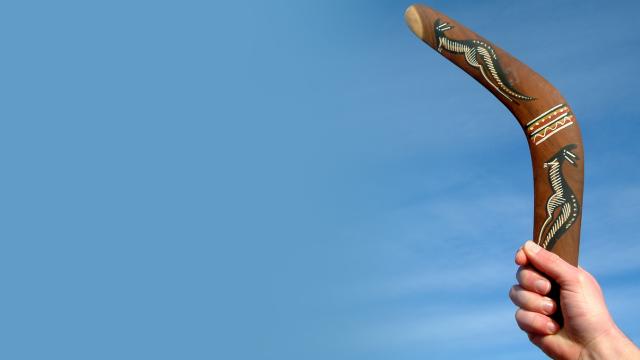Non-returning boomerangs have been used for at least 20,000-30,000 years, with the oldest known example carved from a mammoth’s tusk. These non-returning boomerangs were used for hunting and were carved for straight flight and to stay in the air as long as possible when thrown correctly. The hunter was then able to throw the primitive boomerang great distances and hit an animal to be eaten for dinner. These animals were often small-game, but even the likes of kangaroo or emus can be sufficiently injured by a decently weighted boomerang such that the animal can no longer outrun the hunters.
Possibly while shaping a non-returning boomerang, someone accidentally carved a boomerang into a shape that, when thrown correctly, came careening back toward the owner. It wasn’t exactly useful for hunting or warfare; it was difficult to aim; and if it actually hit its target, it wouldn’t come back anyway.
There is some conjecture that returning boomerangs could have been used for flushing certain game, but there is little in the way of actual evidence to back these claims. As such, most scholars believe that, because returning boomerangs don’t serve much of a functional purpose in hunting, they were simply used for sport, possibly first by the Australian aborigines, though Ancient Egyptians and many other cultures also made them. Tutankhamen actually had a collection of returning (and non-returning) boomerangs.
While there are numerous different ways to make a boomerang, traditionally, returning boomerangs are lightweight, made of wood, and consist of two separate wings which meet at an angle in the middle. That middle section forms the central point around which the wings will be able to spin, stabilizing the flight pattern.
So what makes a returning boomerang come back? Boomerang wings are fashioned much like aeroplane wings. They are flat on the bottom and precisely rounded on the top, which deflects the air such that there is less air pressure above than below. (For a full explanation of how this works and why the commonly touted explanation, that it’s because the air on top, moving over a curved surface, must move faster as it has to travel a greater distance than the air below to meet up at the other end, isn’t quite correct, see: How Do Wings Work)
Of course, as anyone who’s ever tried to throw a boomerang knows, it’s not all about the shape. You also have to throw the boomerang correctly in order to get it to come back to you — that is, you need to throw it somewhat vertically, holding it by one wing, with the other wing pointed up (think opposite to how you would throw a Frisbee), with the centre pointing toward you. Here’s why.
As the boomerang spins through the air, the wing at the top of the spin is moving through the air at a faster rate than the wing at the bottom, because it is moving in the direction of the throw while the wing at the bottom is going the other way. The result is that the top portion will generate more lift than the bottom portion as it cuts through the air.
You might think from this extra lift on the top vs. the bottom that a new rotation will be introduced around the center point and that it would still fly in a mostly straight line. Instead, thanks to its significant angular momentum, this is not the case. The difference in lift between the top and the bottom then creates a torque which ends up tilting the plane of rotation slightly such that the boomerang ends up flying in a curved path through the air. This is more technically known as a torque-induced precession or gyroscopic precession.
Since the torque applied here is going to be reasonably constant through the short flight of the boomerang and the angular momentum likewise stays relatively constant, the boomerang will fly in something of a cone pattern; thus, if thrown correctly and wind or the like doesn’t interfere too much, the boomerang will come right back to you. For those inexperienced with catching the boomerangs and who start out throwing a relatively heavy one, this is not always a good thing.
Bonus Facts:
- The boomerang is generally considered to be the first manmade flying machine.
- Early Australian settlers believed that the boomerangs they saw the aborigines carrying were wooden swords. It was not until 1822 that the word “bou-mar-rang” was recorded with a description of the typical boomerang. The word comes from the Turuwal people who called a returning boomerang a “boornarang.”
- A boomerang is best thrown when it’s being held at approximately a 20 degree angle. Throw it like a baseball by bringing it behind you and snapping your wrist on release, which will give the boomerang the spin it needs to come back to you.
Emily Upton writes for the wildly popular interesting fact website click here or like them on Facebook here. You can also check ’em out on YouTube here.
